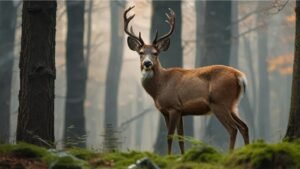White-tailed Deer: Food, Habitat, Adaptation & Hunting
Ever bumped into a white-tailed deer while outdoors? These animals, famed for their white tail and calm nature, have charmed people for hundreds of years. They’ve been a key part of human life, from important symbols for Native Americans to being pursued in modern hunting.

Understanding the White-tailed Deer
The deer we often spot in North and Central America is the white-tailed deer. Its science name is Odocoileus virginianus. Medium-sized, it has a reddish-brown coat. A white belly completes its look. But, the most interesting detail is its white tail. Did you know it uses its tail to send danger messages? Quite cool, right?
- Versatility: The adaptable white-tailed deer can live in various places, from thick forests to broad meadows.
- Social Creatures: They usually live in groups, known as bucks for males and does for females.
- Powerful Senses: These deer are experts at seeing, hearing, and smelling, talents they use for avoiding danger and finding meals.
They are plant-eaters, munching on greenery most of the time. What they eat alters with the seasons, influenced by what foods are at hand.
Key Food Sources:
- Browse: Twigs, leaves, and buds of woody plants
- Forbs: Non-woody plants, such as wildflowers and grasses
- Mast: Fruits, nuts, and seeds, including acorns and berries
Nutritional Needs:
- Protein: Essential for growth and development
- Carbohydrates: Provide energy
- Minerals and Vitamins: Crucial for overall health
White-tailed deer are found far and wide, from the snowy south of Canada to the hot north of Mexico. Their homes?
- Forests: Deciduous, coniferous, and mixed forests
- Prairies: Open grasslands and savannas
- Agricultural Lands: Croplands and pastures
Habitat Preferences:
- Cover: Dense vegetation for protection from predators
- Food Sources: Areas with abundant food resources
- Water: Access to clean water for drinking and cooling
They have developed many changes to survive in their own environments.
Physical Adaptations:
- Hoofs: Provide traction and stability on various terrains
- Strong Legs: Allow for rapid movement and jumping
- Sharp Senses: Aid in detecting predators and finding food
Behavioral Adaptations:
- Camouflage: Their coat blends in with their surroundings
- Alertness: Constant vigilance for potential threats
- Social Behavior: Living in groups provides safety and protection
People’s actions greatly affect white-tailed deer numbers. Hunting, losing their homes, and car accidents are big dangers for these deer.
Conservation Efforts:
- Hunting Regulations: Controlled hunting can help manage deer populations
- Habitat Restoration: Creating and preserving suitable habitat
- Public Education: Raising awareness about the importance of deer conservation
White-tailed deer sure are fascinating! These deer make homes in many places, thanks to their stout hearts and stunning looks. If we learn about their life and issues they face, we can help them survive long-term.

